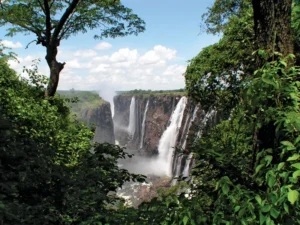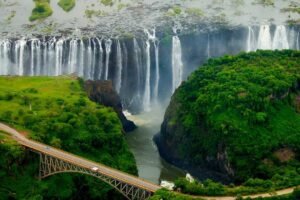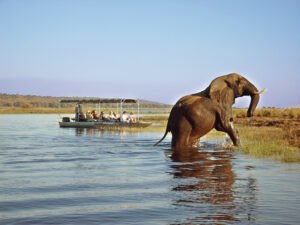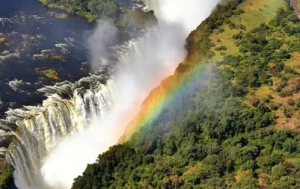



From the moment your plane descends into the dusty red soils and wide savanna plains of Zambia, you sense that this is a country shaped by water and wildness. Rivers cut gorges, waterfalls thunder, life gathers at watering holes, and in the quiet hours you hear lions roar or hippos grunt in the dark. For the curious traveler in 2025, eager for both spectacle and solitude, the best places to visit in Zambia are those that balance dramatic waterfalls with raw wilderness and wildlife encounters.
In this article, I guide you through Zambia’s iconic falls, lesser known cascades deep in remote regions, and wildlife havens where you can track leopards, walk among elephants, or drift down a river in a canoe watching hippos. Along the way I’ll answer how to get there, when to go, what to see, conservation issues, and tips for deeper research.
Table of Contents
-
Introduction: Why Zambia?
-
When to Travel & Seasonal Dynamics
-
Getting Around & Infrastructure
-
Waterfall Highlights
-
Victoria Falls / Mosi-oa-Tunya
-
Lumangwe Falls & Kabwelume
-
Kundalila Falls
-
Ntumbachushi Falls
-
Ngonye Falls
-
Other Waterfalls to Explore
-
-
Wildlife & National Parks
-
South Luangwa National Park
-
Lower Zambezi National Park
-
Kafue National Park
-
Liuwa Plain & Western Circuit
-
Nsumbu, North Luangwa, Sioma Ngwezi
-
Lusenga Plain
-
-
Overlapping Water & Wildlife: River Safaris & Canoe Routes
-
Sample Itineraries
-
Conservation, Community & Responsible Travel
-
Practical Tips & Further Study
-
Conclusion
1. Introduction: Why Zambia?
Zambia is often overlooked in favor of its flashier neighbours, but to the traveler who values depth over gloss, it offers some of the finest waterfall and wildlife experiences in Africa. The best places to visit in Zambia are not just the iconic, but also the hidden — from thundering gorges to quiet forest pools, and from vast game corridors to intimate walking safaris. Zambia boasts a remarkably high number of waterfalls (over 17 documented major ones) and some of Africa’s most pristine national parks. Zambia Tourism+1
This is a land of contrasts: the world-class spectacle of Victoria Falls, and the quieter beauty of remote cascades like Lumangwe. A morning might begin swimming at Devil’s Pool, then shift to a dusk drive in South Luangwa hunting leopards. The narrative of Zambia is water meeting wilderness, and this duality is central to why it’s a prime destination for 2025 and beyond.
2. When to Travel & Seasonal Dynamics
To choose the best times to see both waterfalls and wildlife, you need to understand Zambia’s seasons and hydrology.
2.1 Rainy, Dry & Transition Seasons
-
Rainy season (roughly November to April): Rivers swell, cascades are full, landscapes green, but travel in remote areas may be harder due to muddy roads.
-
Dry season (May to October): Water levels fall, vegetation thins, wildlife concentrates around permanent water, making viewing easier.
-
Transition months (May & October): In May, waterfalls are still near peak, while roads are opening up; in October, water levels drop but wildlife viewing is strong.
For waterfalls, late rainy to early dry season (April to June) often displays full volumes, while some water-based activities (like swimming at Devil’s Pool) are only possible in lower water levels. Go2Africa+2Victoria Falls Africa+2 For wildlife, the best viewing often comes in the dry season (June to September) when animals crowd around rivers and watering holes.
2.2 Waterfall Visibility vs Access
Some waterfalls, especially those deep in the north, are only accessible when roads are passable, so mid to late dry season is safer for accessing remote circuits. On the other hand, if you come too late in the dry season, some waterfalls may have drastically reduced flow (or even dry sections). Planning with local guides and checking recent rainfall in upstream catchments is critical.
2.3 Wildlife Behavior
In the dry season, prey species concentrate around limited water sources, making predator–prey interactions more visible. Conversely, the rainy season brings wide dispersal and lush cover, which can make wildlife spotting harder—but birdlife blooms and migratory species arrive. If your priority is both waterfalls and wildlife, the “shoulder period” around May–June (when waters are still strong and roads improving) is often a sweet spot.
3. Getting Around & Infrastructure
Travel in Zambia is an adventure in itself. The best places to visit in Zambia are often remote, and logistics matter.
3.1 Airports & Regional Flights
The major gateway is Lusaka (Kenneth Kaunda International). From there, domestic flights (e.g. to Mfuwe for South Luangwa, or to Livingstone) can shorten overland journeys. Airlines such as Proflight have expanded routes, including to more remote towns like Kasama, which opens up access to northern waterfalls. Condé Nast Traveler+1
3.2 Road Network & 4×4 Travel
Many roads to remote waterfalls or parks are unpaved and challenging, especially in wet seasons. A 4×4 vehicle is often essential. Some waterfalls have no tarred road access at all. Zambia Tourism+1 Always check local conditions, carry spare parts and emergency gear.
3.3 River & Boat Transport
In places like the Lower Zambezi, canoeing, boat safaris, and river shuttles are integral to the route. Also, national parks bordering rivers may only have boat access to some areas.
3.4 Local Guides & Community Participation
Many remote waterfalls or wildlife corridors are best accessed through local operators who know seasonal routes, river crossings, and village permissions. Partnering with responsible operators helps both safety and community benefit.
4. Waterfall Highlights
Let us now journey through Zambia’s most remarkable cascades, from the globally celebrated to the regionally hidden gems.
4.1 Victoria Falls / Mosi-oa-Tunya (H2: Victoria Falls)
4.1.1 Overview & Geology
Victoria Falls (called Mosi-oa-Tunya, “Smoke That Thunders”) lies on the border of Zambia and Zimbabwe and is Zambia’s most iconic waterfall. Trip.com+3Go2Africa+3Victoria Falls Africa+3 The Zambezi River plunges into a narrow gorge, creating a curtain nearly 1,708 meters wide and up to 108 meters tall, making it one of the world’s largest falling sheets of water. Go2Africa+1
The falls’ volume and mist vary seasonally, and at peak flow can spray mist as high as 400 meters. Go2Africa Zambia’s side allows dramatic close-up views, including walks along the cliff edge paths and vantage points that are less crowded than the Zimbabwe side. Go2Africa+1
4.1.2 Activities at the Falls
-
Rainforest walking trails: Paths wind close to the cliff edge, offering views through spray and rainbows.
-
Helicopter/flights: Bird’s-eye perspective of the entire falls.
-
Devil’s Pool: During lower flow (around September to December), brave travelers can swim in a natural rock pool at the brink of the falls. Trip.com+2Go2Africa+2
-
Livingstone Island tours: Walk to the island from which Livingstone first viewed the falls and explore viewpoints. Go2Africa+1
-
Sunset cruises on the Zambezi above the falls.
-
White-water rafting, gorge swinging, bungee jumping and riverboarding in the lower gorge.
Because Victoria Falls is Zambia’s top attraction, it’s also the entry point to many combined waterfall + wildlife routes.
4.1.3 Visitor Tips & Considerations
-
Best side to stay: The Zambian side offers more intimate access. However, views from Zimbabwe are more sweeping. Many visitors cross the border to see both perspectives. Go2Africa+2Victoria Falls Africa+2
-
When to go: For powerful views, February to May; for safe Devil’s Pool access, September to December. Go2Africa+2Victoria Falls Africa+2
-
Be prepared to get wet: Raincoat, waterproof camera, protective gear.
-
Support local conservation: visitor fees contribute to the Mosi-oa-Tunya National Park buffer zone.
4.2 Lumangwe Falls & Kabwelume Falls
4.2.1 Lumangwe Falls
Lumangwe is the largest waterfall entirely within Zambia (i.e., not shared with a border) and is located on the Kalungwishi River in the north. Wikipedia The falls drop 30–40 m, with widths between 100–160 m. Wikipedia During high water, spray can reach 100 m into the air, and the roar of water in the gorge is powerful. Wikipedia
Less visited than Victoria Falls, it offers quieter experiences. Trails allow views from cliff tops and down into the gorge. Paths lead down to the river and to nearby Kabwelume Falls. Wikipedia
4.2.2 Kabwelume Falls
Just downstream from Lumangwe (about 6 km), Kabwelume forms a semi-circular cascade when river flow is strong. Wikipedia The two together (Lumangwe & Kabwelume) form a dramatic waterfall complex, particularly in April–May. Wikipedia
4.2.3 Access & Experience
Lumangwe is reached via earth roads: from the Kawambwa–Mporokoso gravel road, a turnoff leads ~10 km to the falls. Wikipedia The road condition can be rough, so a 4×4 is recommended. Because tourism is modest here, visitor amenities are basic. Two viewpoints (top and opposite cliff) provide scenic views, and hikers can descend into the gorge. Wikipedia
4.3 Kundalila Falls
In Central Province, near the escarpment of the Muchinga Range, Kundalila Falls (also spelled Nkundalila) is a multi-tiered waterfall dropping around 30 m. Wikipedia The name “Kundalila” roughly translates in Bemba to “crying doves.” Local legend ties to doves and lost gold dust. Wikipedia
At its height, water flows in rivulets that merge and form two cascades before fully cascading into a plunge. During rainy season, the curtain of water is thicker, and rainbows often appear. Wikipedia
To reach it, travelers proceed via Kanona (on the Great North Road), then take a 14 km track to the falls. Wikipedia The site is designated a national heritage monument (since 1964). Wikipedia
4.4 Ntumbachushi Falls
Ntumbachushi is on the Ngona River in Luapula Province. It features twin parallel falls (~10 m each) dropping about 30 m, plus a series of upstream smaller cascades and pools over a stretch of ~2 km. Wikipedia At parts, locals call some sections “the beauty spot,” and swimming is possible in certain seasons. Wikipedia
Access: from Mbereshi on the Kawambwa road, a spur road leads to the site. A steep path climbs along the cliff to vantage points. Wikipedia
4.5 Ngonye Falls (Sioma Falls)
On the Zambezi’s western side in Barotseland, Ngonye Falls (also called Sioma Falls) is less tall (10–15 m) but very broad, forming a broad crescent face in the sandstone. Wikipedia Because of its remoteness and lower tourist pressure, it offers peaceful wilderness experiences. The Ngonye Falls Community Partnership Park aims to bring ecotourism and local benefits. Wikipedia
4.6 Other Waterfalls to Explore
While the above are major highlights, Zambia has many other falls worth exploring:
-
Kalambo Falls — one of Africa’s tallest single-drop falls, on the border with Tanzania (though partly in Zambia).
-
Chishimba Falls — in the northern circuit, with beautiful stepped cascades.
-
Mumbuluma Falls, Chipoma Falls, Nyambwezi Falls, Kabweluma Falls etc. are more remote and less frequented. Zambia Tourism+1
Many of these require local guides and community permission. Their remoteness offers raw, unspoiled experiences.
5. Wildlife & National Parks
Complementing the waterfall experiences is Zambia’s wealth of wildlife ecosystems. The following are among the best places to visit in Zambia for wildlife.
5.1 South Luangwa National Park (H2: South Luangwa National Park)
Often dubbed the “Valley of Leopards,” South Luangwa (Eastern Province) is one of Africa’s top safari destinations. Horizon Guides+2Skyticket+2 It hosts over 60 mammal species and 400+ bird species. Horizon Guides
5.1.1 Wildlife Highlights
-
Leopards are more reliably seen here than in many parks.
-
Also: lions, wild dogs, hyenas, elephants, giraffes, hippos, and a host of antelope.
-
Unique species: the Thornicroft giraffe (found only in this region), Cookson’s wildebeest. Horizon Guides
-
Night safaris: a hallmark of South Luangwa; the park was one of the first to pioneer nighttime wildlife drives. Horizon Guides
-
Walking safaris: because the park is open and habituated, guided walks are feasible, giving an up-close, intimate perspective on nature. Skyticket+1
5.1.2 Access & Best Time
The park is accessed via Mfuwe airport or by road from Lusaka or Chipata. The dry season (July–October) is optimal, when animals concentrate along the Luangwa River and visibility improves.
5.2 Lower Zambezi National Park (H2: Lower Zambezi National Park)
This park lies along the northern bank of the Zambezi River, opposite Zimbabwe’s Mana Pools. Horizon Guides+2Skyticket+2 It’s famed for blending river and land safari.
5.2.1 Wildlife & Activities
-
Elephants, buffalos, lions, leopards, antelopes and more are found in the floodplain corridor. Horizon Guides
-
Boat & canoe safaris: an outstanding way to see aquatic life (crocodiles, hippos, birds) and animals coming to drink.
-
Walking safaris, game drives, night drives.
-
Birdlife is prolific with waterbirds, raptors and riverine species.
5.2.2 Access & Unique Aspects
Accessible via Lusaka and then by road or charter flights. Because of its remoteness, stays often involve lodges that embrace wilderness. It was declared Zambia’s first carbon-neutral national park in 2016 under a REDD+ initiative. Horizon Guides
5.3 Kafue National Park
Kafue is Zambia’s largest national park and one of Africa’s largest protected areas. Its diversity of habitats—floodplains, miombo woodlands, forests, rivers—makes it extraordinarily rich. Zambia Tourism Some parts are still little visited, offering solitude.
Wildlife includes lion, leopard, wild dog, puku, sable antelope, and many bird species. In the Busanga Plains (northern Kafue), abundant wildlife is concentrated seasonally.
5.4 Liuwa Plain & Western Circuit
In Western Province, the Liuwa Plain (connected to the Barotse Floodplain) offers open plains, seasonal flooding, and a migrating wildebeest population. The Lowes road into Sioma Ngwezi and Western circuits also intersects with Ngonye Falls territory.
Wildlife is more sparse than in eastern parks, but part of the appeal is isolation, sky, and the interplay of floodplains, dry seasons, and rural communities.
5.5 Nsumbu, North Luangwa, Sioma Ngwezi
-
Nsumbu National Park (northern arm of Lake Tanganyika) offers forest, lakeshore, aquatic life, and forest game species.
-
North Luangwa is a wild, less-visited extension of the Luangwa system.
-
Sioma Ngwezi lies in southwestern Zambia; remote, cross-border with Angola, combining bush, miombo, and river systems.
These parks are ideal for travelers who want deep wilderness with low visitor volumes.
5.6 Lusenga Plain National Park
Lusenga Plain (Luapula Province) is more recently revived for wildlife. It is home to Lumangwe Falls and has seen species reintroductions (zebra, impala, puku) since 2007. Wikipedia Because of the high rainfall and the Kalungwishi flowing through, this park blends waterfall sighting with wildlife potential.
Historically a hunting ground, Lusenga Plain now offers new opportunities for ecotourism in northern Zambia. Wikipedia
6. Overlapping Water & Wildlife: River Safaris & Canoe Routes (H2: River Safaris & Canoe Routes)
One of Zambia’s greatest charms is where water meets wilderness: the rivers themselves become safari venues.
6.1 Canoe Safaris
In Lower Zambezi and along tributaries of the Luangwa, guided canoe safaris allow silent glides past hippos, crocs, elephants at the riverbank, and birds in riparian trees. These are often cooler, quieter, and more intimate than motorized game drives.
6.2 Boat Safaris & Sundowner Cruises
On the Zambezi above the falls, sunset cruises are classic: wildlife comes to drink at dusk, waterbirds wheel overhead, and crocodiles lurk at the edges. In some parks, boat safaris explore back channels, flooded forests, and tributaries.
6.3 Combined Itineraries
Many safari itineraries combine a waterfall day (e.g. Victoria Falls) with days of river safaris, canoeing, and land game drives. Such combinations allow travelers to see how Zambia’s ecosystems connect: mountains → rivers → floodplains → savannahs.
7. Sample Itineraries
Here are a few sample itineraries (3 to 10 days) to illustrate how these waterfall and wildlife places may be woven into a journey.
7.1 3-Day “Highlights” Circuit
-
Day 1: Arrive in Livingstone, afternoon at Victoria Falls (rainforest walk, viewpoints)
-
Day 2: Morning at Devil’s Pool / Livingstone Island; afternoon Zambezi sunset cruise
-
Day 3: Day safari in Mosi-oa-Tunya National Park or transfer to airport
This gives a fast flavor of Zambia’s waterfall capital.
7.2 7-Day Waterfall + South Luangwa Loop
-
Day 1: Arrive Lusaka → fly to Livingstone
-
Day 2: Full Victoria Falls experience
-
Day 3: Transfer to Mfuwe (South Luangwa)
-
Days 4–6: Safari drives, walking safaris, night drives in South Luangwa
-
Day 7: Return to Lusaka
This focuses on the two star attractions.
7.3 10-Day Northern & Western Waterfall and Park Expedition
-
Day 1: Arrive Lusaka → travel north toward Kasama
-
Day 2: Visit Chishimba Falls
-
Day 3: Move toward Lumangwe / Kabwelume
-
Day 4: Explore Lumangwe, gorge hikes
-
Day 5: Travel across to Ntumbachushi
-
Day 6: Continue to Ngonye Falls
-
Day 7: Safari days in Sioma Ngwezi / Western Park
-
Days 8–9: Return eastwards, optional stop in Kafue or Lusaka
-
Day 10: Depart
This more ambitious route highlights remote waterfalls and wildlife corridors.
8. Conservation, Community & Responsible Travel
8.1 Protected Areas & Funding
Many of Zambia’s national parks and waterfall zones depend on tourism revenue, park fees, and donor support for conservation, anti-poaching, and community buffers. Visitor dollars help maintain park rangers, wildlife monitoring and habitat protection.
8.2 Community-Based Tourism
Many waterfalls lie in or near village lands. Local communities sometimes manage access, guide services, small guesthouses, or crafts. Encouraging local ownership ensures that tourism benefits stay in place. E.g. the Ngonye Falls Community Partnership Park is a model of combining conservation with local livelihoods. Wikipedia
8.3 Environmental Impacts & Sustainability
-
Minimizing waste, plastic, disturbance to wildlife, and off-trail trekking
-
Ensuring watercraft (canoes, motorboats) do not disrupt aquatic life
-
Respecting sacred sites: many waterfalls have spiritual or ancestral importance
-
Supporting reintroduction programs (as in Lusenga Plain) and habitat restoration
9. Practical Tips & Further Study
9.1 Health, Safety & Permits
-
Malaria prophylaxis recommended
-
Yellow fever vaccination may be required depending on origin
-
Park entry permits and guide fees vary by area
-
Travel insurance, spare parts, and emergency plans are essential
9.2 Packing & Gear
-
Waterproof camera, protective bags
-
Rain gear, sun protection
-
Good walking shoes, possibly trekking poles
-
Binoculars and wildlife field guides
9.3 Research & Further Study Suggestions
-
Hydrological studies on Zambezi and tributary flows
-
Ecology of riverine corridors (flora and fauna)
-
Impacts of climate change on seasonal waterfall flow
-
Community-based tourism models in remote waterfall areas
-
Wildlife corridor connectivity between parks
9.4 Useful External & Internal Links
For further travel inspiration, you might explore The Best Places to Visit in Algeria as an internal reference on travel storytelling and structure: https://jetsettrail.com/the-best-places-to-visit-in-algeria/
For broader Africa travel context, see this article on top destinations in 2025: The Best Places to Go in Africa in 2025 Condé Nast Traveler
Additionally, the official Zambia Tourism site provides updated listings of waterfalls and national parks. Zambia Tourism+1
10. Conclusion
If you ask me: the best places to visit in Zambia in 2025 are not just the obvious ones—but the ones you don’t hear much about until you arrive. Yes, Victoria Falls must be on the list, but pair it with Lumangwe’s roaring beauty, the shy charm of Ngonye Falls, and deep safari in South Luangwa or Lower Zambezi, and you get a journey of water, wilderness, and wonder.
This country rewards the curious traveler with contrasts: thunderous cascades and silent riverbank afternoons; sweeping vistas and hidden pools; solitary trails and large mammal herds. Whether you are a naturalist, researcher, photographer, or simply a traveler who yearns to get off the beaten path, Zambia offers a wealth of stories waiting to be learned.


